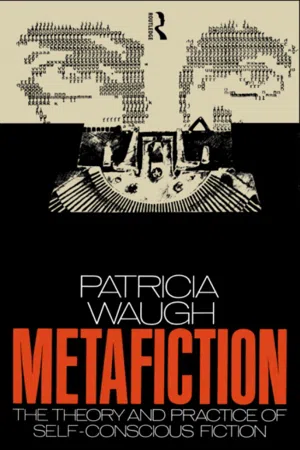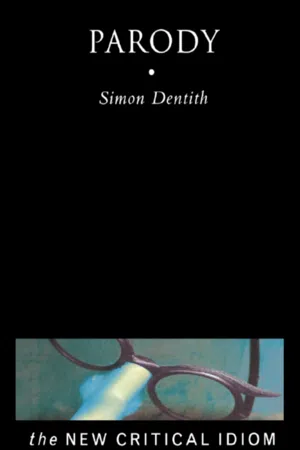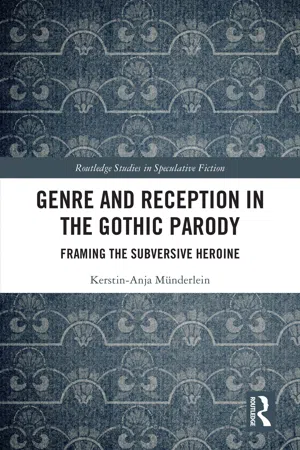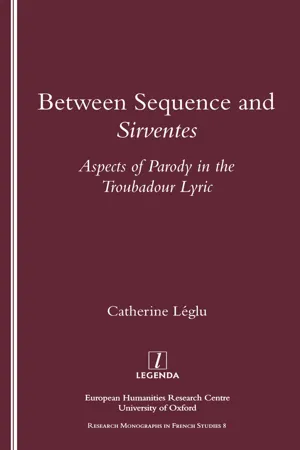Parody
Parody in literature is a form of imitation that humorously exaggerates the style, tone, or content of a work to create a comedic effect. It often involves mimicking the original work while adding a satirical or mocking twist. Parody can be used to critique or comment on the original work, as well as to entertain and amuse audiences.
8 Key excerpts on "Parody"
- eBook - ePub
Metafiction
The Theory and Practice of Self-Conscious Fiction
- Patricia Waugh(Author)
- 2002(Publication Date)
- Routledge(Publisher)
...148) Parody fuses creation with critique to replace, as one observer has remarked, what had become ‘a matter of course’ with what now becomes a ‘matter of discourse’ (Stewart 1979, p. 19). The specific method of Parody, the actual process involved in this substitution, has been usefully explained as: a kind of literary mimicry which retains the form or stylistic character of the primary work, but substitutes alien subject matter or content. The parodist proceeds by imitating as closely as possible the formal conventions of the work being parodied in matters of style, diction, metre, rhythm, vocabulary. (Kiremidjian 1969, p. 232) In other words, Parody renews and maintains the relationship between form and what it can express, by upsetting a previous balance which has become so rigidified that the conventions of the form can express only a limited or even irrelevant content. The breaking of the frame of convention deliberately lays bare the process of automatization that occurs when a content totally appropriates a form, paralysing it with fixed associations which gradually remove it from the range of current viable artistic possibilities. The critical function of Parody thus discovers which forms can express which contents, and its creative function releases them for the expression of contemporary concerns. Parody has, of course, always performed these functions: Walter Shandy’s hovering foot, for example, in Tristram Shandy (1760), is on one level a direct critique of the mimetic fallacy of Richardson’s exhaustive attention to detail. On another level, however, it provides a more general insight into the very essence of narrative – its inescapable linearity, its necessary selectiveness as it translates the non-verbal into the verbal – and finally creates its own comedy out of its critique...
...This can have some odd effects, even running counter to the apparent intentions of the parodist. Thus the classic Parody of Don Quixote (discussed more fully in the next chapter) preserves the very chivalric romances that it attacks—with the unexpected result that for much of its history the novel has been read as a celebration of misplaced idealism rather than a satire of it. In the following chapters I shall have frequent cause to refer to this ‘parodic paradox’—understood as the generation of further writing out of the assault upon stigmatised forms that the Parody is supposed to bring to a halt. Parody can act to preserve the very forms that it attacks. I have defined Parody, in a deliberately widely drawn definition, as any cultural practice which makes a relatively polemical allusive imitation of another cultural production or practice. The point of this definition was to situate Parody in the to-and-fro of language, and to suggest a similarity between the everyday rejoinders of speech and the competitive relations between texts. This is a definition based upon the function of Parody in the continuance of human discourse, not upon the formal means by which Parody is achieved. Tight definitions of a formal kind can be attempted, but they have the disadvantage of having to deal with large numbers of incompatible definitions and differing national usages. In my account, Parody is to be thought of as a mode, or as a range in the spectrum of possible intertextual relations. The specific means by which the polemical purposes of Parody are achieved need to be described locally. It follows from this that the functions which Parody serves can vary widely, so that it is impossible to specify any single social or cultural direction for the mode. In fact, the social and cultural meanings of Parody, like all utterances, can only be understood in the density of the interpersonal and intertextual relations in which it intervenes...
- eBook - ePub
- Horst Ruthrof(Author)
- 2016(Publication Date)
- Routledge(Publisher)
...Unlike the equivalent items in the original text, all these features are meant to be realized in their aesthetic and not their pragmatic function. It is of course possible to misread both the source text and the Parody by responding to the former as to a Parody (which happens quite often as a result of linguistic incompetence on the part of the producer) or the latter as a practical manual (as a result either of the incompetence of the parodist or the insensitivity of the reader). Parody as an artistic structure stands in a distorting relationship over and against its source object. This is the crucial part of the general definition of Parody. Two issues must be kept separate here: what is being distorted and the degree of modification that has occurred. In literary Parody the question as to what has been distorted can best be answered by studying the particular stratum or strata on which the parodic attitude has concentrated. We must find out whether it is the level of print, the linguistic arrangement of the text, the signified image world, or the work’s overall artistic-ideological pattern that is predominantly parodied. Once we have identified the stratum at which the parodic distortion is most effectively aimed, we should be able, by way of comparison with the original text, to describe the degree of modification. To my mind, this is the point where the critical vocabulary of travesty, burlesque, reductive or augmentive Parody has a clearly defined and useful job to do. In isolation, without a comprehensive theoretical framework of which they are functional parts, such critical terms remain arbitrary and confusing. We cannot do full justice to Parody, however, if we confine our description to its artistic status and distorting relationship with its source. We must include the fact that at least potentially Parody can always transcend the structure it ridicules...
- eBook - ePub
Volume 15, Tome V: Kierkegaard's Concepts
Objectivity to Sacrifice
- Steven M. Emmanuel, William McDonald, Jon Stewart(Authors)
- 2016(Publication Date)
- Routledge(Publisher)
...Parody/Satire Mads Sohl Jessen Parody (Parodi —noun; parodiere —verb); Satire (Satire —noun; satirisere —verb) From ancient Greek παρῳδία, a vulgar or burlesque poem (the prefix παρα- means “beside,” “parallel to,” or, as here, “mock,” and ᾠδή means “song,” “ode”). Its lexical meaning in Danish is either that of a literary work caricaturing another work or it may refer to a person or something being mocked or distorted for humorous and/or ridiculing purpose. 1 The concept of satire derives from French satire and Latin satira, a poem lambasting persons and vices. 2 I. Parody Kierkegaard tends to use the concept in the temporal sense of something evolving over time in a negative direction or becoming a lesser or lower embodiment of what it used to be. On November 20, 1836, he wrote on a loose paper that “in my opinion, every development is only complete when its Parody has been produced, it will turn out that politics is the Parody of the development of the world.” 3 Kierkegaard’s use of the concept of Parody as pertaining to a necessary historical decline is common in his early writings. In a journal entry also from 1836 he refers to his theory of decline as a necessity with respect to the idiomatic saying that old age is a second childhood: “The parodic (as the final stage of development) also manifests itself in the way in which childhood repeats itself in old age: ‘to enter into one’s second childhood.’” 4 Kierkegaard also finds proof of the necessary parodic conclusions of certain religious developments...
- eBook - ePub
- Giorgio Agamben, Jeff Fort(Authors)
- 2020(Publication Date)
- Zone Books(Publisher)
...C HAPTER F IVE Parody In her novel Arturo’s Island, Elsa Morante presents a concealed meditation on Parody that very likely makes a decisive statement about her poetics. The term Parody (with a capital P) appears rather unexpectedly as an insulting epithet for one of the central characters of the novel, Wilhelm Gerace, the idol and father of Arturo, the story’s narrator. 1 When Arturo hears the word for the first time (or, rather, when he translates it from the secret language of whistles that he believes he alone shared with his father), he is uncertain of its meaning. In order not to forget it, he mentally repeats it to himself as he returns home, where he consults a dictionary and finds the following definition: “Imitation of someone else’s verse in which what is serious in the other becomes ridiculous, comic, or grotesque.” 2 This intrusion of a definition from a manual of rhetoric into a literary text cannot be a matter of chance. Especially since the term reappears shortly before the end of the novel, in an episode that contains the final revelation that leads to Arturo’s separation from his father, the island, and his childhood. The revelation is this: “Your father is a Parody!” 3 Recalling the dictionary definition, Arturo futilely searches the thin, gracious face of his father for the comic or grotesque features that might justify the epithet. A little later, he realizes that his father is in love with the man who insulted him. The name of a literary genre is here the cipher of an inversion involving the object of desire rather than the transposition of the serious into the comic. It could also be said that the character’s homosexuality is a cipher that indicates he is nothing other than a symbol for the literary genre with which the narrative voice (which is obviously also the voice of the author) has fallen in love...
- eBook - ePub
Genre and Reception in the Gothic Parody
Framing the Subversive Heroine
- Kerstin-Anja Münderlein(Author)
- 2021(Publication Date)
- Routledge(Publisher)
...In most cases, this discrepancy between Gothic novel and Gothic Parody is achieved through the target of its humour and the Gothic Parody is, at least partly, funny because of its deviation from the original Gothic frame established initially through the Gothic novel. The main source of humour in more than half of the parodies under scrutiny in this book derives from the juxtaposition of “Gothic behaviour” in one or several of the characters before a rather realistic backdrop, which shows how unlikely the events and perfectly unrealistic the characters are in the Gothic novel. In these cases, the Parody is predominantly a vehicle to transport another form of narrative, mainly that of the moral tale or the conduct book. In such narratives, one or a few characters within the narrative are deluded or quixotic readers who behave in accordance with the Gothic frame exclusively, thus presenting themselves as ludicrously overstrained characters lacking a sound mind, and their delusion is recognised not only by the reader but by the other characters as well. This delusion serves as a caveat to the reader, thereby making a point of warning its readers against flights of fancy induced by an overconsumption of (inadequate) literature. Such a Parody definitely serves a critical function in that it shows how detrimental the loss of reality can be for the central, deluded character, usually a young woman, culminating in one instance even in an extramarital affair that leaves the heroine unmarried and with child (Romance Readers). Ultimately, the questions that will always remain with any Parody is if the Parody could also be read as a serious representative of the hypogenre. Depending on how well the Gothic frame is invoked through publication and marketing, a potential reader might believe they are reading a Gothic novel. Within this frame, they will soon experience discrepancies and the Parody will “give itself away” more or less clearly...
- eBook - ePub
- Walter Nash(Author)
- 2014(Publication Date)
- Routledge(Publisher)
...This striking comparison suggests that Parody appraises – learns the way of walking – in order to ridicule and discomfit. But not all Parody is hostile; many acts of literary caricature and burlesque show affectionate familiarity with the things they imitate, and are a form of positive criticism, of stylistic analysis, and ultimately of tribute. If there are malign witches, there are also benevolent warlocks, who learn the steps in order to show just how well the ‘victim’ dances. Parody of a personal style often aims to do just that. It is the shortest and most concrete way of commenting on typical features of syntax, lexicon, phonology, prosody, and all the apparatus of learned dissertation. The point is illustrated by the following attempt, on my part, to Parody the distinctive poetic idiom of Gerard Manley Hopkins: G. M. HOPKINS TAKES LUNCH IN THE RESTAURANT CAR Ah, waiter, are there any any, where are, tell me, come, Napkins, lovely all-of-a-starch-staring Linen, preferably, or pauper-seeming paper, waiter? Wearing My gaygear goodsuit, ah, my dear, dim was it? dumb? Well, this train’s tripping and track-truckling as I sipped Soup, did, ah God, the hot of it! – yes, slipped, flipped Into my lap, slapping, of this clear consommé, some Spoonflung flashes, splashes for bosom’s bearing. Bring me a – coo – lummy – here dab, here dry with a kerchief, tea-towel, toilet-roll, oh-dear-then-a-doyly, but merely A move (with a mercy, man) make! Oh what a slanting that sheerly, What with the canting curve of the, what with the lilt of the lurch, Hurled leaping lapward, all in a skirl, the dear drenching. There was a splash to abash one quaintly, ah, there was a quenching! Since when, on seat’s edge sodden I pensive perch, Picking at lunch unlovely, unappetizing nearly. The intention of this light-hearted exercise is certainly not to stage a satirical attack on a sage and serious poet...
- eBook - ePub
Between Sequence and Sirventes
Aspects of the Parody in the Troubadour Lyric
- Catherine Leglu(Author)
- 2017(Publication Date)
- Routledge(Publisher)
...Chapter 4 Rewriting and the Role of Serious Parody The author or performer of Parody tends to occupy a subordinate place, not simply as a copyist of the model, but also as its envious spectator or pupil. The metaphors applied to the author of Parody show a tendency to see the performance as parasitic or criminal; the terms 'vampire', 'cannibal', 'thief or 'usurper' convey a negative vision of Parody hard to reconcile with its depiction elsewhere as licensed play. 1 When two poets engage in combative rewriting, this aggression cannot be far from the surface, as the dialogue between Peire d'Alvernha and his predecessor Marcabru will show. Paul Lehmann's study of Latin Parody offers the possibility of reading either ludic or polemical intentionality into texts. For example, the lament of Job, 'Versa est in luctum cithara mea et organum in vocem flentium' [My harp has been tuned for a dirge, my flute to the voice of those who weep] (Job 30:31) can become an erotic complaint, 'Vertitur in luctum/organum amoris', or an introduction to a satirist's song: 'Versa est in luctum/cythara Waltheri'. 2 Both parodies are secularizations of sacred text, but it is not clear if they would have been received as a profanation of the text concerned. While the author of the erotic song is punning on school-learned images of grieving, Walter of Châtillon invites the spectator or reader to align his suffering as a satirist with the sufferings of Job. In so doing, he illustrates the parodist's characteristic usurpation of an authoritative voice by making use of a commonly known text, and places himself as the object of the Parody. Similarly, another song by Walter opening 'Ecce sonat en aperto/Vox clamantis in deserto' (see Isaiah 40:3) equates his reprobate persona as a goliard with that of a prophet preaching unheeded in the desert...







